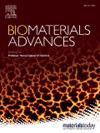Ultrasound-switchable piezoelectric BiVO4/fullerene heterostructure for on-demand ROS modulation in MRSA-infected diabetic wound healing
IF 6
2区 医学
Q2 MATERIALS SCIENCE, BIOMATERIALS
Materials Science & Engineering C-Materials for Biological Applications
Pub Date : 2025-04-11
DOI:10.1016/j.bioadv.2025.214307
引用次数: 0
Abstract
Persistent microbial infections and excessive reactive oxygen species (ROS) accumulation severely impede diabetic wound healing. Herein, we developed an ultrasound-switchable BiVO4/fullerene piezoelectric heterostructure via a one-pot solvothermal method, enabling on-demand transition between bactericidal action and ROS scavenging for treating infected diabetic wounds. Under 8-min ultrasound (US) irradiation, the heterojunction sonosensitizer leveraged piezoelectric polarization to generate substantial ROS in real-time through a narrowed energy band gap and enhanced charge carrier separation and migration efficiency, resulting in the disruption of bacterial membrane integrity and 99.9 % eradication of methicillin-resistant Staphylococcus aureus (MRSA). Upon US withdrawal, the sonosensitizer spontaneously transitioned to an antioxidative state through fullerene-mediated ROS scavenging, effectively neutralizing excess ROS and restoring cellular redox balance. In an MRSA-infected diabetic wound model, this ultrasound-responsive duality effectively suppressed bacterial proliferation, reduced inflammation, enhanced angiogenesis, and ultimately accelerated wound healing within 14 days. This ultrasound-switchable therapeutic strategy offers promising insights for managing drug-resistant infections and other ROS-mediated biomedical challenges.
超声可切换压电BiVO4/富勒烯异质结构在mrsa感染的糖尿病伤口愈合中的按需ROS调节
持续的微生物感染和过多的活性氧(ROS)积累严重阻碍糖尿病伤口愈合。在此,我们通过一锅溶剂热方法开发了一种超声可切换的BiVO4/富勒烯压电异质结构,实现了杀菌作用和活性氧清除作用之间的按需转换,用于治疗感染的糖尿病伤口。在8分钟超声(US)照射下,异质结声敏剂利用压电极化,通过缩小能带隙,增强电荷载流子分离和迁移效率,实时产生大量活性氧,从而破坏细菌膜的完整性,99.9%地消灭耐甲氧西林金黄色葡萄球菌(MRSA)。在US退出后,声敏剂通过富勒烯介导的ROS清除自发过渡到抗氧化状态,有效中和多余的ROS并恢复细胞氧化还原平衡。在mrsa感染的糖尿病伤口模型中,这种超声反应性有效地抑制了细菌增殖,减少了炎症,增强了血管生成,并最终在14天内加速了伤口愈合。这种超声切换治疗策略为管理耐药感染和其他ros介导的生物医学挑战提供了有希望的见解。
本文章由计算机程序翻译,如有差异,请以英文原文为准。
求助全文
约1分钟内获得全文
求助全文
来源期刊
CiteScore
17.80
自引率
0.00%
发文量
501
审稿时长
27 days
期刊介绍:
Biomaterials Advances, previously known as Materials Science and Engineering: C-Materials for Biological Applications (P-ISSN: 0928-4931, E-ISSN: 1873-0191). Includes topics at the interface of the biomedical sciences and materials engineering. These topics include:
• Bioinspired and biomimetic materials for medical applications
• Materials of biological origin for medical applications
• Materials for "active" medical applications
• Self-assembling and self-healing materials for medical applications
• "Smart" (i.e., stimulus-response) materials for medical applications
• Ceramic, metallic, polymeric, and composite materials for medical applications
• Materials for in vivo sensing
• Materials for in vivo imaging
• Materials for delivery of pharmacologic agents and vaccines
• Novel approaches for characterizing and modeling materials for medical applications
Manuscripts on biological topics without a materials science component, or manuscripts on materials science without biological applications, will not be considered for publication in Materials Science and Engineering C. New submissions are first assessed for language, scope and originality (plagiarism check) and can be desk rejected before review if they need English language improvements, are out of scope or present excessive duplication with published sources.
Biomaterials Advances sits within Elsevier''s biomaterials science portfolio alongside Biomaterials, Materials Today Bio and Biomaterials and Biosystems. As part of the broader Materials Today family, Biomaterials Advances offers authors rigorous peer review, rapid decisions, and high visibility. We look forward to receiving your submissions!

 求助内容:
求助内容: 应助结果提醒方式:
应助结果提醒方式:


